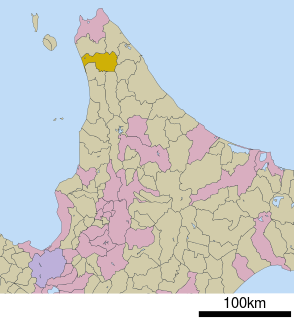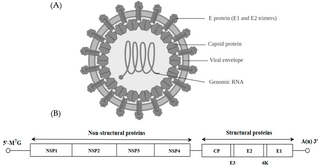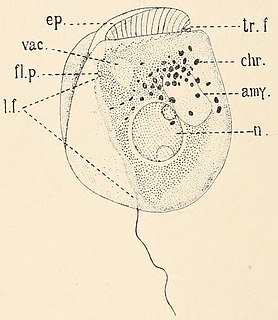
Rubella virus (RuV) is the pathogenic agent of the disease rubella, transmitted only between humans via the respiratory route, and is the main cause of congenital rubella syndrome when infection occurs during the first weeks of pregnancy.

Caulobacterales is an order of gram-negative pseudomonadota within the alpha subgroup.

Bunyavirales is an order of segmented negative-strand RNA viruses with mainly tripartite genomes. Member viruses infect arthropods, plants, protozoans, and vertebrates. It is the only order in the class Ellioviricetes. The name Bunyavirales derives from Bunyamwera, where the original type species Bunyamwera orthobunyavirus was first discovered. Ellioviricetes is named in honor of late virologist Richard M. Elliott for his early work on bunyaviruses.

Horonobe-cho is a town located in Sōya Subprefecture, Hokkaido, Japan. There is a JR train station, Horonobe Station which connects Horonobe-town with other cities in Hokkaido.
The family Micrococcaceae includes bacterial genera of Gram positive cocci that inhabit the air and skin, such as Micrococcus luteus.

Alphavirus is a genus of RNA viruses, the sole genus in the Togaviridae family. Alphaviruses belong to group IV of the Baltimore classification of viruses, with a positive-sense, single-stranded RNA genome. There are 32 alphaviruses, which infect various vertebrates such as humans, rodents, fish, birds, and larger mammals such as horses, as well as invertebrates. Alphaviruses that could infect both vertebrates and arthropods are referred dual-host alphaviruses, while insect-specific alphaviruses such as Eilat virus and Yada yada virus are restricted to their competent arthropod vector. Transmission between species and individuals occurs mainly via mosquitoes, making the alphaviruses a member of the collection of arboviruses – or arthropod-borne viruses. Alphavirus particles are enveloped, have a 70 nm diameter, tend to be spherical, and have a 40 nm isometric nucleocapsid.

The snow sheep, or Siberian bighorn sheep, is a species of sheep from the mountainous areas in the northeast of Siberia. One subspecies, the Putorana snow sheep (Ovis nivicola borealis), lives isolated from the other forms in the Putoran Mountains.
Saccharomyces pastorianus is a yeast used industrially for the production of lager beer, and was named in honour of Louis Pasteur by the German Max Reess in 1870. This yeast's complicated genome appears to be the result of hybridisation between two pure species in the Saccharomyces species complex, a factor that led to difficulty in establishing a proper taxonomy of the species.

Sindbis virus (SINV) is a member of the Togaviridae family, in the Alphavirus genus. The virus was first isolated in 1952 in Cairo, Egypt. The virus is transmitted by mosquitoes. SINV is linked to Pogosta disease (Finland), Ockelbo disease (Sweden) and Karelian fever (Russia). In humans, the symptoms include arthralgia, rash and malaise. Sindbis virus is widely and continuously found in insects and vertebrates in Eurasia, Africa, and Oceania. Clinical infection and disease in humans however has almost only been reported from Northern Europe, where SINV is endemic and where large outbreaks occur intermittently. Cases are occasionally reported in Australia, China, and South Africa.
Mycobacterium mucogenicum
Etymology: mucogenicum, from the organism's highly mucoid appearance.
Lachancea kluyveri is an ascomycetous yeast associated with fruit flies, slime fluxes, soils and foods.

Corticovirus is a genus of viruses in the family Corticoviridae. Corticoviruses are bacteriophages; that is, their natural hosts are bacteria. The genus contains two species. The name is derived from Latin cortex, corticis. However, prophages closely related to PM2 are abundant in the genomes of aquatic bacteria, suggesting that the ecological importance of corticoviruses might be underestimated. Bacteriophage PM2 was first described in 1968 after isolation from seawater sampled from the coast of Chile.

Amphidinium is a genus of dinoflagellates. The type for the genus is Amphidinium operculatum Claparède & Lachmann. The genus includes the species Amphidinium carterae which is used as a model organism.

Marseilleviridae is a family of viruses first named in 2012. The genomes of these viruses are double-stranded DNA. Amoeba are often hosts, but there is evidence that they are found in humans as well. The family contains one genus and four species, two of which are unassigned to a genus. It is a member of the nucleocytoplasmic large DNA viruses clade.
Exiguobacterium is a genus of bacilli and a member of the low GC phyla of Bacillota. Collins et al. first described the genus Exiguobacterium with the characterization of E. aurantiacum strain DSM6208T from an alkaline potato processing plant. It has been found in areas covering a wide range of temperatures (-12 °C—55 °C) including glaciers in Greenland and hot springs in Yellowstone, and has been isolated from ancient permafrost in Siberia. This ability to survive in varying temperature extremes makes them an important area of study. Some strains in addition to dynamic thermal adaption are also halotolerant, can grow within a wide range of pH values (5-11), tolerate high levels of UV radiation, and heavy metal stress.
Streptomyces mutabilis is a bacterium species from the genus of Streptomyces which has been isolated from soil. Streptomyces mutabilis produces the antibiotic mutalomycin.
Phasmaviridae is a family of viruses with negative stranded RNA genomes associated with insect hosts. They are a member of the order Bunyavirales. Phasmaviruses were first discovered in phantom midges of the genus Chaoborus in 2014.
Enteractinococcus is a Gram-positive genus of bacteria from the family Micrococcaceae.
Enteractinococcus fodinae is a bacterium from the genus of Enteractinococcus.
Sulfurisphaera tokodaii is a thermophilic archaeon of the Thermoproteota phylum. This species lives can grow as a chemoheterotroph and a lithoautotroph









